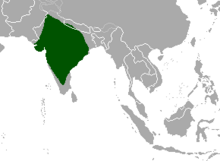Nilgai
| Nilgai | |
|---|---|
 |
|
| Scientific classification | |
| Kingdom: | Animalia |
| Phylum: | Chordata |
| Class: | Mammalia |
| Order: | Artiodactyla |
| Family: | Bovidae |
| Subfamily: | Bovinae |
| Genus: |
Boselaphus Blainville, 1816 |
| Species: | B. tragocamelus |
| Binomial name | |
|
Boselaphus tragocamelus (Pallas, 1766) |
|
 |
|
| Range of the nilgai | |
| Synonyms | |
|
|
The nilgai or blue bull (Boselaphus tragocamelus) (pronounced /ˈnɪlˌgaɪ/, literally meaning "blue cow") is the largest Asian antelope and is endemic to the Indian subcontinent. The sole member of the genus Boselaphus, the species was described and given its binomial name by German zoologist Peter Simon Pallas in 1766. The nilgai stands 1–1.5 metres (3.3–4.9 ft) at the shoulder; males weigh 109–288 kilograms (240–635 lb), and the lighter females 100–213 kilograms (220–470 lb). A sturdy thin-legged antelope, the nilgai is characterised by a sloping back, a deep neck with a white patch on the throat, a short crest of hair along the neck terminating in a tuft, and white facial spots. A column of pendant coarse hair, hangs from the dewlap ridge below the white patch. Sexual dimorphism is prominent – while females and juveniles are orange to tawny, adult males have a bluish-grey coat. Only males possess horns, 15–24 centimetres (5.9–9.4 in) long.
The nilgai is diurnal (active mainly during the day). The animals band together in three distinct kinds of groups: one or two females with young calves, three to six adult and yearling females with calves, and all-male groups with two to 18 members. Typically tame, the nilgai may appear timid and cautious if harassed or alarmed; it flees up to 300 metres (980 ft)-or even 700 metres (2,300 ft), galloping away from the source of danger. Herbivores, nilgai prefer grasses and herbs, though they commonly eat woody plants in the dry tropical forests of India. Females become sexually mature by two years, while males do not become sexually active until four or five years old. The time of the year when mating takes place varies geographically, but a peak breeding season lasting three to four months can be observed at most places. Gestation lasts eight to nine months, following which a single calf (sometimes twins or even triplets) is born. As typical of several bovid species, nilgai calves stay hidden for the first few weeks of their lives. The lifespan of the nilgai is around ten years.
...
Wikipedia

